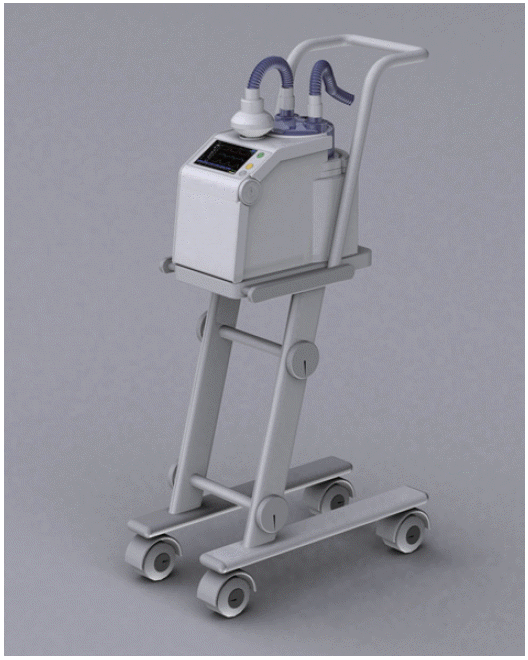INTRODUCTION
Obstructive sleep apnea (OSA) is due to upper airway obstruction leading to intermittent hypoxia, sleep fragmentation, metabolic syndrome, increased cardiovascular morbidity and mortality.1–3 At present, continuous positive airway pressure (CPAP) is the most effective and widely used therapy.4 However, about 50% of patients with OSA will either refuse or not tolerate the use of CPAP therapy.5,6 The adherence to CPAP treatment seems even lower in stroke or heart failure patients.7 Therefore, improved therapeutic strategies are required to treat OSA.
Recently, high flow nasal cannula (HFNC) therapy was developed for critically ill patients. It could increase pharyngeal pressure by delivering warm and humidified air through the nose.8 We report herein a case of a patient in whom HFNC was used for OSA treatment.
CASE REPORT
A 71 year-old Korean man was brought to the emergency department in an ambulance complaining of chest pain. He had a history of hypertension, diabetes mellitus and cerebral infarction at the right frontal area in 1995. He also had a myocardial infarction and stent insertion at the left anterior descending artery in 2008. Ischemic cardiomyopathy was developed with an ejection fraction of 41%. In the emergency room, electrocardiography showed ST elevation and elevated cardiac enzymes: CK-MB (N: 0–2.8) 28.2 ng/mL and Troponin I (N: 0–0.045) 12.8 ng/mL. Coronary artery angiography showed a three-vessel disease which was not amenable to percutaneous intervention. Consequently, he underwent cardiovascular bypass surgery. After surgery, he was admitted to the coronary care unit (CCU) for close monitoring. During sleep his oxygen saturation went down to 68% with a severe snoring and obstructive sleep apnea. Since his condition did not allow for polysomnography, we tried to treat him using an auto-positive airway pressure (APAP) device at a pressure level of 5–9 cmH2O in the CCU. However, he could not tolerate the pressure and refused to use the APAP device. Instead of positive airway pressure therapy, we decided to try HFNC therapy using OmniOx® (Sudo Healthcare Inc., Seoul, Korea) (Fig. 1). We used the OmniOx® remote control capabilities to titrate the amount of airflow in the sleep laboratory. The titration with HFNC was similar to that with CPAP under polysomnography. For this particular patient, the HFNC titration was 45 L/m. On that flow, his apnea-hypopnea index and respiratory arousal index were less than 5/h and oxygen desaturation episodes disappeared. He was transferred to the general ward where HFNC therapy was continued with good compliance. He was discharged with the HFNC and was still using it at his 6 month follow-up.
DISCUSSION
This is a case report showing that HFNC can be titrated and used for OSA patients. Although previous studies could not titrate the airflow amount of HFNC, it was already known that HFNC could reduce apnea-hypopnea in OSA patients.9 The improvement in apnea-hypopnea can be attributed primarily to the increase in the inspiratory airflow.10 Inspiratory airflow increases approximately 50 mL/s per 1 cmH2O of CPAP pressure.11 HFNC at a rate of 20 L/m leads to a 45 mL/s increase in inspiratory airflow which is similar to the CPAP airflow.9 The increased inspiratory airflow can lead to an increase in the end-expiratory pharyngeal pressure which alleviates upper airway obstruction. An additional benefit of HFNC is that insufflating air directly into the nose can produce concomitant reductions in dead space ventilation. Therefore, improvements in oxygen, ventilation and sleep continuity along with enhanced upper airway patency are likely responsible for these benefits.
High flow nasal cannula lowered the apnea-hypopnea in all subjects, regardless of the apnea-hypopnea distribution. However, marked improvements can be expected primarily in patients with hypopnea rather than apnea.8 In patients with apnea, the increased end-expiratory pharyngeal pressure with HFNC would not be enough. HFNC is more effective in improving apnea-hypopnea in rapid eye movement (REM) sleep compared to non rapid eye movement (NREM) sleep.8 REM sleep is characterized with a loss in muscular tone and a decrease in ventilator demand. It is possible that small increases in pharyngeal pressure are more effective in stabilizing upper airway in the condition of hypotonic state during REM sleep compared to tonic state in NREM sleep.12 Additionally, HFNC can have increased tidal inspiratory volumes and satisfy a patient’s ventilator demand during REM sleep. In fact, the response rate of HFNC is higher in patients with predominant apnea-hypopnea events in REM than NREM sleep.8,13 Patients with predominant central sleep apnea respond poorly to HFNC. Additional airflow from HFNC leads to an exaggeration of ventilator overshoot and consequently reduces CO2. This condition increases central sleep apnea.
Continuous positive airway pressure is still the most effective therapy for OSA patients. However, reduced compliance with CPAP can significantly compromise long-term therapeutic effectiveness, leaving a lot of patients untreated over time.14 The poor compliance of CPAP has been attributed to uncomfortable masks and to difficulties in exhaling against a high positive air pressure.15 However, HFNC uses a simplified nasal interface and delivers relatively low levels of positive air pressure. Therefore, we expect good long-term compliance and overall therapeutic efficacy. In this case, the patient uses HFNC with satisfaction. Previous studies showed that HFNC had a good therapeutic effect in OSA patients but the HFNC airflow could not be titrated. In this case a remote control system facilitated the airflow titration. We believe that HFNC should be titrated individually like a CPAP. It will improve the efficacy and compliance of HFNC therapy. This case showed that if an OSA patient is not compliant with CPAP therapy, HFNC can be considered as a second option. Large-scale prospective studies are warranted to verify this.












